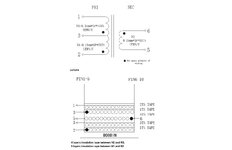cupoftea
Advanced Member level 5
Just reviewing a 12Vout, 10W Flyback for 240VAC/415VAC input.
Must also withstand 458VAC for when "loss of neutral".
Fsw = 60kHz
Fet vds = 900V
Core is EF12.6 (E13/7/4) but bobbin has no added "platform" to make it survive 3500VAC Hipot test.
The transformer spec says its HiPot test was "1.5kV/5mA/1s"
.....Never seen this low test voltage used for txformer on 458VAC (649Vpk) before. Usually AYK its 3.5kV and for 1 min.
Primary is just 156 turns of 0.15mm enam copper wire
Secondary is just 18 turns of 0.35mm enam copper wire.
No margin tape and no triple insulated wire used.
Its a non isolated design, pri and sec to the same ground. Not aware of the regs for this?
Must also withstand 458VAC for when "loss of neutral".
Fsw = 60kHz
Fet vds = 900V
Core is EF12.6 (E13/7/4) but bobbin has no added "platform" to make it survive 3500VAC Hipot test.
The transformer spec says its HiPot test was "1.5kV/5mA/1s"
.....Never seen this low test voltage used for txformer on 458VAC (649Vpk) before. Usually AYK its 3.5kV and for 1 min.
Primary is just 156 turns of 0.15mm enam copper wire
Secondary is just 18 turns of 0.35mm enam copper wire.
No margin tape and no triple insulated wire used.
Its a non isolated design, pri and sec to the same ground. Not aware of the regs for this?
Last edited:
